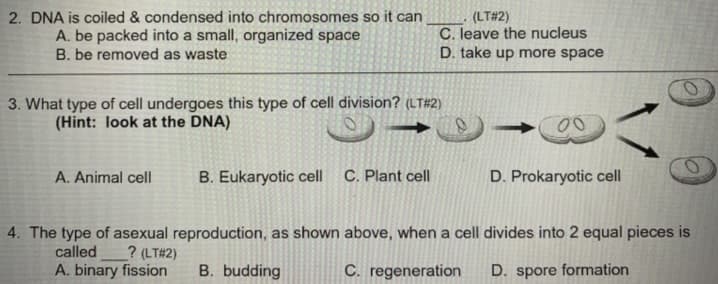(LT#2) . DNA is coiled & condensed into chromosomes so it can A. be packed into a small, organized space B. be removed as waste C. leave the nucleus D. take up more space . What type of cell undergoes this type of cell division? (LT#2) (Hint: look at the DNA) A. Animal cell B. Eukaryotic cell C. Plant cell D. Prokaryotic cell The type of asexual reproduction, as shown above, when a cell divides into 2 equal pieces is called ? (LT#2) A. binary fission B. budding C. regeneration D. spore formation

DNA( deoxyribonucleic acid) is the double-stranded molecule that is the genetic material in most animals except for some viruses. A nitrogen base, sugar molecule, and phosphate groups make a nucleotide. Nucleotides are the structural components of nucleic acids. DNA is made up of a deoxyribose sugar, phosphate group, and four nitrogen bases- adenine, guanine, thymine, and cytosine. The two strands of DNA are complementary to each other. They are joined by the hydrogen bonds between the nitrogen bases. The nitrogen base on one strand bonds with the nitrogen base on the adjacent strand. This base pairing is specific and complementary. The adenine (A) base pairs with thymine (T) by a double hydrogen bond. The guanine (G) base pairs with cytosine (C) by a triple hydrogen bond.
Trending now
This is a popular solution!
Step by step
Solved in 4 steps







